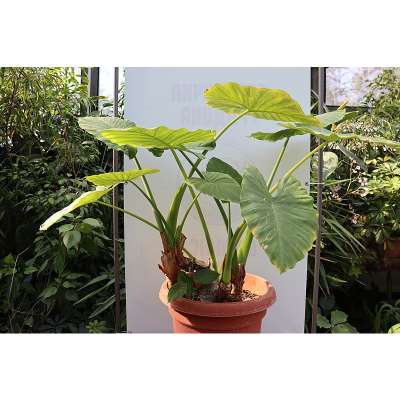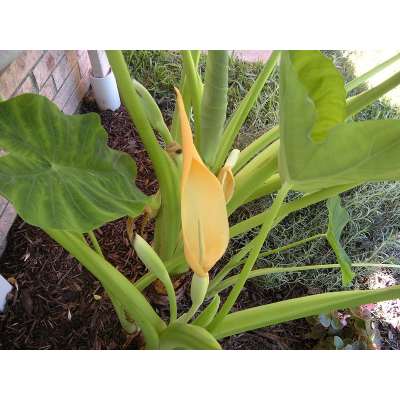Elephant Ear Plant broken stem caused by pets, wind storms, deer, Children and Other. For Partial or Split-Off Stem Issues, You Can use remedies Such as Tapping and Wiring. However, When a Stem Is Completely Broken, the Most Effective Solution Is to Trim It Off, Resolving the Problem.
In the world of gardening, the majestic Elephant Ear plant, with its large, striking leaves, can truly make a statement in your garden. However, the beauty of these plants can be disrupted when the stem is broken. Fear not, for in this article, we will explore the reasons behind this botanical misfortune and delve into the ways to repair the broken stem, ensuring your Elephant Ear plant thrives once more.
How Can Damage Occur to Your Elephant Ears Plant?
Stem Split in Half
Sometimes, the stem of your Elephant Ear plant may be split in half, creating a concerning situation for the plant’s overall health.
Elephant Ear plants, with their substantial leaves, are top-heavy, which makes them vulnerable to stem splitting. Strong winds, heavy rainfall, or even the plant’s own weight can lead to this unfortunate occurrence.
Partially Broken Stem
On other occasions, the stem may only be partially broken, leaving you with a less dire but still pressing concern.
Partial stem damage can occur when the plant is subjected to stress from external factors, such as animals or people brushing against it. This can cause the stem to bend or weaken.
Completely Broken Stem
A completely broken stem is a more severe scenario. The stem is separated into two distinct parts, and the plant is left in a vulnerable state.
Complete stem breakage can be attributed to a variety of factors, including extreme weather conditions and accidents involving the plant.
Only a Leaf Section Breaking Off
Sometimes, it’s not the stem but a section of a leaf that breaks off, leaving a portion of the plant’s beauty compromised.
Leaf sections breaking off can result from careless handling or even insects nibbling on the leaves. It’s a common issue but not as serious as stem damage.
A Completely Broken Stem Overlapping a Newly Developed One
In some cases, you may find a completely broken stem overlapping with a newly developed one. This can be confusing and may require specialized attention.
The overlap between a broken and new stem may occur due to the plant’s natural growth and recovery process. Understanding this situation is vital for successful repair.

What Are the Causes of Stem Breakage?
Wind
The relentless force of the wind is a common cause of stem damage in Elephant Ear plants. Their broad leaves act as sails, making them susceptible to wind-induced stress.
Strong gusts of wind can bend, twist, or even snap the stem in half. This is more likely to happen during storms or in areas with frequent wind.

Wildlife such as Deer
Wildlife can also pose a threat to your Elephant Ear plants, particularly if you live in an area frequented by deer.
Deer may graze on the plant’s lush leaves and inadvertently damage the stems. This can lead to partial or complete breakage, impacting the plant’s overall health.
Children in the Neighborhood
If you have children in the neighborhood, your Elephant Ear plant might be at risk of accidental damage.
Kids are naturally curious, and they might not realize the fragility of your plant. They may accidentally break the stems while playing around the garden.
Accidental Impact from a Baseball
Sports enthusiasts should take extra care if they have Elephant Ear plants in their yard.
An errant baseball or other flying objects from outdoor activities can collide with the plant, leading to stem damage. This type of injury is sudden and often unexpected.
Damage to the Fence
The proximity of your Elephant Ear plant to a fence can be problematic.
Stems may get caught in the fence, leading to breakage. It’s essential to maintain a safe distance between the plant and the fence to avoid this situation.
Pets Jumping on the Plant
If you have pets, you might have to deal with the challenge of them jumping on your precious Elephant Ear plant.
Pet paws and playful antics can lead to stem damage. It’s important to train your pets to avoid the plant to prevent any further harm.
How to Repair a Broken Stem on an Elephant Ears Plant
Now that we’ve explored the causes of stem damage, let’s shift our focus to repairing these beautiful plants when adversity strikes.
Gently Tap the Stem Back into Place
If you notice that the stem has split or partially broken, your first course of action is to gently tap it back into place.
- Step 1: Carefully hold the damaged stem.
- Step 2: Gently push the two parts of the stem back together.
- Step 3: Ensure they are aligned as closely as possible.
- Step 4: Use a soft tie, like garden twine or plant tape, to secure the stems together.
Gently tapping the stem back into place is most effective when the break is not severe and the stem can still bend without snapping.
Provide Support with Wiring
For more significant stem damage, you may need to provide additional support to encourage healing.
- Step 1: Identify the broken section.
- Step 2: Use a flexible garden wire.
- Step 3: Wrap the wire around the stem above and below the break.
- Step 4: Tighten the wire gently but not too tightly to avoid further damage.
- Step 5: Make sure the broken section is secure.
This method helps the plant recover by preventing further damage and promoting mending.
Utilize a Wooden Stick for Additional Support
In cases where the stem break is more extensive, using a wooden stick can be beneficial.
- Step 1: Find a smooth, clean wooden stick.
- Step 2: Place the stick alongside the broken stem.
- Step 3: Use garden twine or plant tape to secure the stick and stem together.
- Step 4: Ensure the stick provides adequate support.
The wooden stick acts as a splint for the broken stem, aiding in the healing process.
Trim Off Completely Broken Stems
For stems that are completely broken and cannot be repaired, it’s best to trim them off.
- Step 1: Identify the damaged section.
- Step 2: Use clean, sharp pruning shears.
- Step 3: Cut the stem above and below the break.
- Step 4: Remove the damaged portion.
- Step 5: Dispose of the cut portion properly.
Removing completely broken stems prevents any potential diseases from spreading to the rest of the plant.
Consider Relocating the Plant if It’s Near a Fence
If your Elephant Ear plant is positioned too close to a fence and has been damaged due to this proximity, you might need to consider relocating it.
- Step 1: Choose a new location for your plant.
- Step 2: Carefully dig up the plant.
- Step 3: Replant it in the new location.
Relocating the plant provides a fresh start and minimizes the risk of further damage.
Take Measures to Protect the Plant from Mischievous Neighborhood Children
If neighborhood children have been causing damage to your Elephant Ear plant, it’s important to address the issue with a preventive approach.
- Step 1: Have a friendly conversation with parents or guardians of the children.
- Step 2: Educate the children about the fragility of the plant.
- Step 3: Consider installing a protective barrier around the plant, like a low fence.
By addressing the issue at its source and providing protection, you can help safeguard your plant from future damage.
Train Your Pet to Avoid the Plant to Prevent Future Damage
For those with playful pets that have been causing harm to the Elephant Ear plant, training is the key to prevention.
- Step 1: Consistently train your pet to avoid the plant.
- Step 2: Use positive reinforcement and rewards for good behavior.
- Step 3: Create a designated play area for your pet.
Training your pet to stay away from the plant will ensure its long-term health and beauty.
In conclusion, the Elephant Ear plant, with its grandeur and charm, can be susceptible to stem damage. However, with the right knowledge and a gentle touch, you can repair and protect these botanical wonders. By understanding the causes and employing the appropriate methods, you can ensure your Elephant Ear plant continues to thrive and adorn your garden with its majestic presence.
Read Next : Why Are my String of Dolphins Flat? Solution of Flattening Leaves
